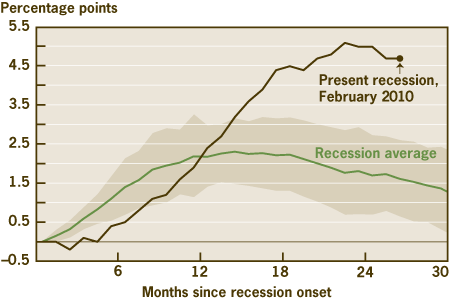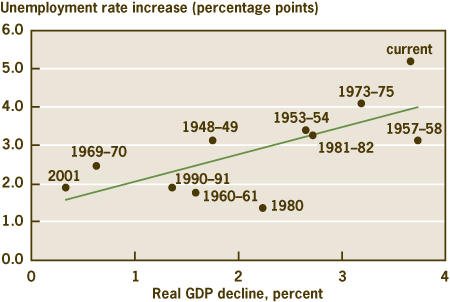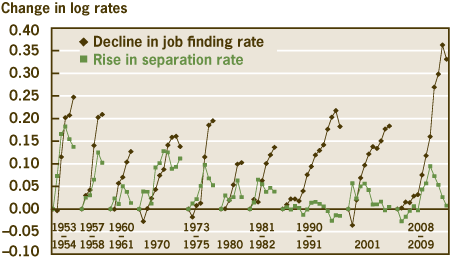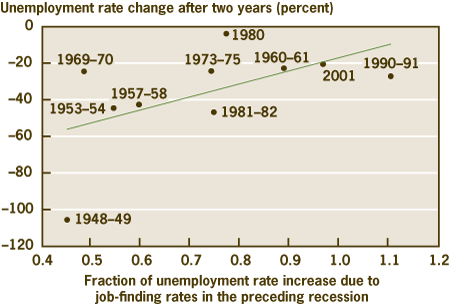- Share
Are Jobless Recoveries the New Norm?
Recent recessions have been followed by exceptionally slow recoveries in the labor market, and the current recession is shaping up to follow the same pattern. We take a close look at some labor market measures and uncover a difference between these recent recessions and those that preceded them—workers are staying unemployed longer. This difference is a clue we can use to predict how the current labor market recovery might proceed in the near future.
The views authors express in Economic Commentary are theirs and not necessarily those of the Federal Reserve Bank of Cleveland or the Board of Governors of the Federal Reserve System. The series editor is Tasia Hane. This paper and its data are subject to revision; please visit clevelandfed.org for updates.
Recent recessions have been followed by exceptionally slow recoveries in the labor market, and the current recession is shaping up to follow the same pattern. We take a close look at some labor market measures and uncover a difference between these recent recessions and those that preceded them—workers are staying unemployed longer. This difference is a clue we can use to predict how the current labor market recovery might proceed in the near future.
The recession that began in December 2007 may have ended, but all signs point to a prolonged recovery in the labor market. Comparing this recession to those of the past reveals that it is more like the previous two and less like earlier ones, suggesting that the path of the recovery will be similar to the previous two as well—the so-called jobless recoveries. If recent patterns hold, the negative effects of this recession are likely to linger a while in the labor market.
In search of further insight that might help predict the pace of recovery, we take a closer look at the factors that contribute to the rise in the unemployment rate during recessions. We find that the past three recessions differed from earlier ones in that workers stayed unemployed longer once they lost their job.
This finding implies a troubling trend. Longer unemployment spells are a problem not only because they mean newly unemployed workers have a harder time finding jobs, but also because workers who are unemployed for too long can lose industry- and job-specific skills. Losing skills can reduce their odds of finding a job during the recovery as well as lower their productivity when they finally do find one.
Current measures of the demand for workers by firms also suggest new jobs may be slow in coming. The evidence there suggests that firms are more likely to begin rebuilding their workforces by increasing the hours of workers who are currently underemployed before they create many new jobs, reinforcing the likelihood of a prolonged jobless recovery.
How This Recession Compares to Those of the Past
The recent downturn, which appears to have ended in the third quarter of 2009, will likely be the longest since 1945. It is also already associated with the largest drop in payroll employment of any U.S. recession and the biggest jump in the unemployment rate. (Employment and unemployment figures come from different surveys—payroll employment comes from a survey of firms and the unemployment rate comes from a survey of households.) From the beginning of the recession in December 2007 to the end of February 2010, total nonfarm payroll employment has declined about 8.4 million, or 6.1 percent. In the same period, the unemployment rate jumped from 5 percent to 10.1 percent (in October) before coming down to 9.7 percent today, which amounts to more than 7.1 million additional unemployed workers. By all these measures, the deterioration in labor market conditions has been particularly stark.
In a typical postwar business cycle, the unemployment rate starts leveling off about 14 months after the start of recession (recessions typically last around 10 months), but it usually takes more than 30 months to return to pre-recession levels. Of course, each recession follows its own course and might deviate some from this average, but the range of most likely paths (indicated by one standard deviation around the mean in figure 1) also confirms this broader pattern.
Figure 1. Cumulative Increase in Unemployment Rate, Beginning of Recession to 30 months Out

Notes: The x-axis represents months from start of the recession. The green line represents the average unemployment rate progression for post-World War II recessions, and the shaded region is +/- one standard deviation.
Source: Bureau of Labor Statistics.
The current labor market downturn presents a drastically different picture. First of all, the unemployment rate did not stop rising until 23 months after the start of the recession. Moreover, the cumulative rise so far is well above the range we have seen before. Overall, it seems like the path of the unemployment rate in the present downturn will be a significant outlier, featuring a steep and prolonged rise from its pre-recession level.
Similarly, in a typical recession, payroll employment starts to decline at the start of the official NBER recession and takes about 12 month to stabilize. Unlike the unemployment rate, however, payroll employment comes back to its pre-recession level relatively quickly once the recession ends, on average 21 months after the start of the recession. The past two recessions, in 1990–91 and 2001, were exceptions. It took 31 and 47 months, respectively, for employment to recover. Consequently, these periods commonly came to be called jobless recoveries.
The pattern of employment decline in the present downturn resembles that of the last jobless recovery in many ways, which suggests we are in for a very large decline over a prolonged period. In terms of the net job loss, this recession is already the worst recession in our sample, around 6.1 percent of pre-recession employment, and it happened over the course of only two years.
However, one might argue that the unusual pattern of this downturn might be explained by the severity of the recession. It is true that, in general, the magnitude of the decline in real GDP during a recession is strongly correlated with the decline in payroll employment and the rise in the unemployment rate (see figure 2 for the relationship with the unemployment rate). The correlation holds somewhat for the recent recession, real GDP has fallen 3.7 percent overall from the fourth quarter of 2007 (the cycle’s peak) to the second quarter of 2009 (the bottom according to the most recent data). So even though the decline in employment and the jump in the unemployment rate in this recession are both large, they do not seem exceptionally high given the size of the aggregate shock to GDP.
Figure 2. Real GDP and Unemployment

Sources: Bureau of Labor Statistics; Bureau of Economic Analysis.
But the correlation with GDP doesn’t tell us what it is about a recession that makes it likely to be followed by a jobless recovery. Nearly every recession since 1945 fits the pattern, too. To find a difference that sheds some light on future labor market recovery, we look into the different factors that contribute to the rise in the unemployment rate during recessions.
How Job Separation and Finding Rates Affect the Recovery
The unemployment rate reports the number of workers who are unemployed as a fraction of the labor force, but it does not tell us whether the unemployment rate is high because people are staying unemployed longer or because more workers have lost their jobs. That information is given by job finding and separation rates. In any given month, some unemployed workers find jobs and some employed workers lose theirs, leading to a flow of workers out of and into the unemployment pool. We define the average rates at which these flows occur as job finding and separation rates, respectively.
Recessions can differ in how much either of these rates contribute to the overall increase in unemployment, and we find that such differences affect the course of the recovery. We measured the degree to which each of these rates contributed to the rise in the unemployment rate in all post–WWII recessions (applying the methodology of Elsby et al., 2009, and Shimer, 2007) and found some patterns that distinguish the past three recessions from earlier ones.
In general, during recessions, separations start rising as the economy enters a downturn, and job finding rates start declining (see figure 3). After some initial rise in unemployment, mostly in the form of layoffs, separations usually start tapering off before the unemployment rate peaks. What accounts for most of the subsequent rise in the unemployment rate is the low rate of job finding among the unemployed, implying that the average duration of unemployment goes up. This suggests that most firms are not ready to begin rehiring as soon as they stop cutting jobs, even though they may have significantly reduced their payrolls. As the economy finally starts recovering, durations get shorter because firms create new jobs, and absorb part of the unemployed.
Figure 3. Changes in Job Finding and Separation Rates by Recession, 1948–Present

Notes: The percent decline in real GDP is measured peak to trough (2009:Q2 for the last recession) around NBER recessions, and the percent rise in unemployment is from the start of the recession to the unemployment peak and measured at quarterly frequency. The unemployment peak for the current downturn indicates the last quarter (2009:Q4).
Sources: Bureau of Labor Statistics; author’s calculations.
During the past three recessions, though, the decline in the job finding rate has been playing a bigger role in unemployment rate fluctuations. Relative to the change in separations, the job finding rate changed (declined) much more in the last three episodes.
The pattern of these rates in the 2008–2009 recession seems like that of the previous two. The decline in the job finding rate during the past several quarters is the largest in history and well above the respective rise in the separation rate. Though separations increased sharply early on in the recession, more than 95 percent of the change in the unemployment rate since the recession’s onset can be explained by the decline in job finding rates. In other words, the sharp rise in unemployment that we have seen is not due primarily to a wave of job losses but rather to the fact that once unemployed, workers’ chances of finding employment have fallen dramatically.
It is not yet clear why the job finding rate played such a significant role in the past three recessions. But just knowing the rate’s contribution has been changing can still tell us something about the shape of the recovery. A dominant role for the job finding rate during a recession means longer unemployment durations, and that could translate into a number of important consequences for the recovery.
To start with, long-term unemployment reduces workers’ human capital by weakening their industry- and occupation-specific skills and reducing their productivity when they find a job. Once these workers do find a job, data show that their new starting wages stay lower than similarly educated workers and that this disparity continues for a long time. Additionally, many workers might be tempted to take up the first job they find after a long spell of unemployment, regardless of how good a match the job is for them. They will also be more likely to change employers when job prospects improve. Since recruiting for workers and looking for a job consume resources, this excessive labor market churning could be detrimental to overall productivity during the recovery. Consequently, lower job finding rates during the recession could lower the standard of living and slow the rate of employment gains during the recovery.
Longer Durations and a Slow Recovery?
The analysis of job finding and separation rates clearly shows that unemployment durations are getting longer, most likely because firms are reluctant to call back workers even well after they have stopped laying them off. In fact, both the mean and median unemployment duration are currently at 29.7 and 19.4 weeks, respectively, close to their record-high levels. These measures also disguise the significant number of workers who are out of work for even longer periods. For instance, among those who are unemployed, 41 percent have been out of work for more than six months, the highest this statistic has ever been.
Another statistic suggests that some of these unemployed workers will not be able to immediately find work: the fraction of unemployed workers who have been laid off temporarily. Traditionally, some employers lay off workers with an implicit (or explicit) understanding that they will be recalled when the economy improves. Temporary layoffs save both parties from having to spend time and effort searching for a job or a worker when the need for labor increases. Usually, the fraction of the unemployed who are on temporary layoffs jumps at the beginning of recessions. Currently, this measure stands at around
10 percent, but it did not increase much during the recession; if anything, it fell slightly. This implies that firms do not perceive the employment adjustment they are going through as temporary or that conditions are such that they are willing to incur costly hiring efforts after the recession.
One might argue that the longer durations that result from lower job finding rates may reflect a permanent mismatch of skills between the unemployed and the needs of employers. The low levels of temporary layoffs suggest that the skills of some of these unemployed workers are specific to industries that may end up significantly smaller after the recession. Potential examples are construction, financial services, and manufacturing, which were hit hard by the recession. However, it is relatively early to claim this with certainty, as it might be some time before we observe any permanent effects on these industries.
To the extent that the foregoing arguments are true, we might expect to have an unemployment rate that stays relatively high even after the recession. As a matter of fact, looking at every recessionary episode in the post–WWII era, we find that when the fraction of unemployment due to a low job-finding rate is large, the subsequent recovery in unemployment is small and drawn out (figure 4). The correlation between these two measures is around 0.55.
Figure 4. Contribution of Job-Finding Rate in Recessions and the Unemployment Recovery After

Sources: Bureau of Labor Statistics; author’s calculations.
Labor Demand
Ultimately, whether we have a muted, jobless recovery or a rapid one featuring full employment gains will depend on the demand for labor. The unemployment rate is stabilizing, but unfortunately, the demand for workers has not been showing any signs of major improvement yet.
To gauge the unmet demand for labor we can look at the number of job openings by establishments, a measure of which is provided by the BLS as part of its Job Openings and Labor Turnover Survey (JOLTS). The job openings rate measures vacant positions as the ratio of vacancies that firms are actively recruiting for to total positions (employed workers plus vacancies). The rate currently stands at 2.1 percent, a bit higher than its lowest level of 1.8, since the series began in December 2000 and well below its pre-recession peak of 3.4 percent.
Of course, some kinds of slack might exist that prevent rising demand for labor from translating immediately into new jobs. Employers could potentially ask for more hours from their current employees before hiring new workers. The average weekly hours of production workers, which at 33.1 hours stands near its lowest-ever level of 33.0 hours, indicates that this is likely to happen. Similarly, part-time employees can be made full-time workers. A good measure of this potential slack is the number of workers employed part-time for economic reasons. This number has jumped by more than 4.1 million since December 2007, indicating a potentially large pool of underemployed workers is already on payrolls. This significant underemployment could be a major contributor to a jobless recovery.
References
- “Jobless Recovery Redux?” Mary Daly, Bart Hobjin, and Joyce Kwok. Federal Reserve Bank of San Francisco, Economic Letter, no. 2009–18.
- “The Ins and Outs of Cyclical Unemployment.” Michael Elsby, Ryan Micheals, and Gary Solon. American Economic Journal: Macroeconomics, vol.1, no.1, January 2009.
- “Sectoral Shifts and Cyclical Unemployment,” David M. Lilien, Journal of Political Economy, vol. 90, no. 4, 1982.
- “Reassessing the Ins and Outs of Unemployment,” Robert Shimer, NBER working paper no. 13421, 2007.
- “Another Jobless Recovery?” Mark Schweitzer, Federal Reserve Bank of Cleveland, Economic Commentary, March 2003.
Suggested Citation
Tasci, Murat. 2010. “Are Jobless Recoveries the New Norm?” Federal Reserve Bank of Cleveland, Economic Commentary 2010-01. https://doi.org/10.26509/frbc-ec-201001
This work by Federal Reserve Bank of Cleveland is licensed under Creative Commons Attribution-NonCommercial 4.0 International




